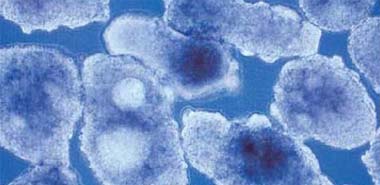
7月20日,据英国《独立报》报道,两个美国科研小组宣称,他们首次发现,成人细胞在被重新编程为诱导多功能干细胞(iPS)的过程中并不会放弃其对原始组织的“记忆”,在直接使用iPS细胞分化成移植用人体组织时,可能会产生问题。
其中一个科研小组来自美国波士顿儿童医院,该小组领导人乔治戴利表示,iPS细胞会保留对用来制造它的原初组织(比如皮肤)的“记忆”,这一新发现对目前方兴未艾的干细胞临床和科研提出了挑战。
干细胞是未充分分化、具有自我更新和分化潜能的细胞。科学家认为,使用干细胞,可以诱导分化出可替换掉人体病变组织的任何组织和细胞。另外,科学家还希望使用干细胞修改基因突变,剔除致病基因,从根本上消除疾病。
基于此,干细胞研究广受关注。迄今为止,唯一被证明能够安全和有效地制造出干细胞的方式是以存在巨大伦理争议的胚胎为基础,通过细胞核移植或者克隆获得胚胎干细胞。
2007年11月,美日科学家分别宣布发现了将普通皮肤细胞转化为干细胞的方法,他们将这样得到的干细胞称为诱导多功能干细胞(iPS)。iPS细胞具有和胚胎干细胞类似的功能,却绕开了胚胎干细胞研究面临的伦理和法律等障碍,因此,在医疗领域的应用前景非常广阔。
最新发现却表明,这些iPS细胞并不能像人类胚胎干细胞一样起作用,它们不能完全地通过重新编程回到最原始的胚胎阶段,如果在移植过程中使用这样获得的iPS细胞,将产生一定的问题。
不过,戴利也表示,iPS拥有“记忆”是把双刃剑。它可让病人通过利用自身血液iPS细胞获取血液细胞变得更容易,只有在使用iPS细胞获得一些身体组织来治疗诸如糖尿病、帕金森病等时,这种“记忆”才有可能带来干扰。
麻省总医院科研小组也证实了iPS细胞拥有这样的“记忆”能力,其研究人员康拉德霍舍得林格在《自然生物技术》杂志上称,保留对原初组织的记忆会影响iPS细胞分化为其它细胞的能力,但通过让iPS细胞不断分裂的方法,这种“记忆”还是可以消除的。
生物谷提供索引:Jose M Polo,Susanna Liu,Maria Eugenia Figueroa,Warakorn Kulalert,Sarah Eminli,Kah Yong Tan,Effie Apostolou,Matthias Stadtfeld,Yushan Li,Toshi Shioda,Sridaran Natesan,Amy J Wagers,Ari Melnick,Todd Evans" Konrad Hochedlinger.Cell type of origin influences the molecular and functional properties of mouse induced pluripotent stem cells.Nature Biotechnology,2010.doi:10.1038/nbt.1667 By Bioon.com
作为2007年最具影响力的科学事件,iPS的诞生在干细胞研究领域激起了巨大波澜,尔后越来越多的国家跻身于此,力图获得有利竞争态势。两个美国科研小组这一最新发现,无疑给如日中天的iPS泼了瓢冷水。正如不能指望一名天天想家的士兵义无反顾地冲锋陷阵,若iPS总是“念念不忘”原初组织,何以不负众望地堪当再生医疗的大任?无论这个难题最终能不能解决、怎样解决,都说明要用iPS完全取代胚胎干细胞,绝没有想像的那么容易。(生物谷Bioon.com)
生物谷推荐原文出处:
Nature doi:10.1038/nature09342
Epigenetic memory in induced pluripotent stem cells
K. Kim,A. Doi,B. Wen,K. Ng,R. Zhao,P. Cahan,J. Kim,M. J. Aryee,H. Ji,L. I. R. Ehrlich,A. Yabuuchi,A. Takeuchi,K. C. Cunniff,H. Hongguang,S. Mckinney-Freeman,O. Naveiras,T. J. Yoon,R. A. Irizarry,N. Jung,J. Seita,J. Hanna,P. Murakami,R. Jaenisch,R. Weissleder,S. H. Orkin,I. L. Weissman,A. P. Feinberg" G. Q. Daley
Somatic cell nuclear transfer and transcription-factor-based reprogramming revert adult cells to an embryonic state, and yield pluripotent stem cells that can generate all tissues. Through different mechanisms and kinetics, these two reprogramming methods reset genomic methylation, an epigenetic modification of DNA that influences gene expression, leading us to hypothesize that the resulting pluripotent stem cells might have different properties. Here we observe that low-passage induced pluripotent stem cells (iPSCs) derived by factor-based reprogramming of adult murine tissues harbour residual DNA methylation signatures characteristic of their somatic tissue of origin, which favours their differentiation along lineages related to the donor cell, while restricting alternative cell fates. Such an ‘epigenetic memory’ of the donor tissue could be reset by differentiation and serial reprogramming, or by treatment of iPSCs with chromatin-modifying drugs. In contrast, the differentiation and methylation of nuclear-transfer-derived pluripotent stem cells were more similar to classical embryonic stem cells than were iPSCs. Our data indicate that nuclear transfer is more effective at establishing the ground state of pluripotency than factor-based reprogramming, which can leave an epigenetic memory of the tissue of origin that may influence efforts at directed differentiation for applications in disease modelling or treatment.







